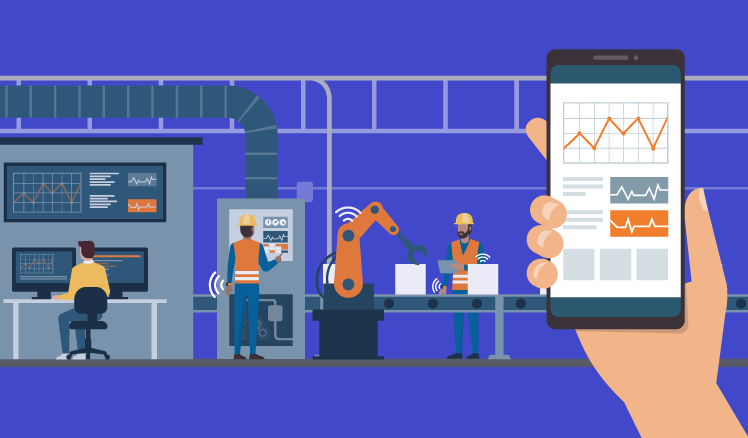Machine learning (ML) and artificial intelligence (AI) play a significant role in IoT data analytics, enabling insights, predictions, and automation. Here’s how ML and AI are applied in IoT:
- Anomaly Detection and Predictive Maintenance:
ML algorithms can analyze historical and real-time IoT data to detect anomalies and predict equipment failures or maintenance needs. By learning patterns and identifying deviations, ML models can alert operators to potential issues in advance, minimizing downtime and optimizing maintenance schedules. - Predictive Analytics and Forecasting:
ML models can analyze IoT data to make predictions and forecasts. For example, in agriculture, ML can analyze weather data, soil conditions, and sensor measurements to predict crop yields or disease outbreaks. In supply chain management, ML can forecast demand based on historical sales data and external factors. - Real-time Decision Making: ML models can be deployed at the edge or fog layer to perform real-time analysis and decision-making. This reduces latency and allows for immediate action based on data insights. For example, ML can trigger automated actions such as adjusting settings, sending alerts, or activating actuators to respond to detected events or conditions.
- Edge Computing and Inferencing:
AI and ML algorithms are increasingly deployed at the edge, close to IoT devices, enabling real-time inferencing and decision-making. This approach reduces latency, conserves bandwidth, and enhances privacy by processing data locally. Edge ML models can perform tasks like image recognition, audio processing, and sensor data analysis. - Adaptive Control and Optimization:
ML algorithms can optimize IoT systems by learning from data and adjusting control parameters in real-time. For example, ML models can dynamically adjust heating, ventilation, and air conditioning (HVAC) settings based on occupancy patterns or energy consumption data, leading to energy savings and improved comfort. - Natural Language Processing (NLP) and Voice Interfaces:
NLP and voice interfaces are used to interact with IoT devices using natural language commands and queries. AI-powered virtual assistants, such as Amazon Alexa or Google Assistant, can control IoT devices, retrieve information, and perform tasks based on voice commands, enhancing user experience and convenience. - Computer Vision and Object Recognition:
Computer vision techniques, powered by ML algorithms, can analyze video or image data from IoT devices to recognize objects, detect anomalies, or enable surveillance. For example, security cameras can use ML models to identify potential threats or analyze customer behavior in retail settings. - Energy Management and Optimization:
ML and AI can optimize energy consumption in IoT systems. ML algorithms can learn from historical energy usage patterns and optimize energy allocation based on real-time data, weather forecasts, and occupancy patterns. This approach helps reduce energy waste and supports efficient energy management. - Personalized Experiences and Recommendations:
ML algorithms can analyze user behavior, preferences, and historical data from IoT devices to provide personalized experiences and recommendations. For example, smart home systems can learn user preferences for lighting, temperature, and entertainment and automatically adjust settings accordingly. - Adaptive Behavior and Optimization: ML models can adapt and learn from changing IoT environments. This enables them to optimize operations, resource allocation, and energy usage. For instance, ML algorithms can dynamically adjust lighting, temperature, or power consumption based on occupancy levels or external conditions.
- Cognitive IoT: By integrating AI capabilities, IoT devices can exhibit cognitive behavior, such as natural language processing and speech recognition. This enables human-machine interaction, voice-based commands, and intelligent personal assistants within the IoT ecosystem.
- Data Privacy and Security: The vast amount of data generated by IoT devices raises concerns about data privacy and security. ML and AI applications must adhere to strict data protection measures to ensure the confidentiality and integrity of the data being processed at various layers of the system.
- Scalability: ML models require computational resources and memory. Implementing ML algorithms at the edge or fog layer of an IoT network may require significant computing power and storage capabilities. Ensuring scalability and efficiency in resource-constrained IoT devices can be a challenge.
- Interoperability and Standardization: Integration of ML and AI capabilities across different IoT devices and platforms requires interoperability and standardization. Establishing common frameworks, protocols, and data formats for ML model deployment and communication is essential for seamless integration and collaboration.
- Model Training and Maintenance: ML models require training using extensive and representative datasets. Collecting and labeling such data can be challenging and time-consuming, especially in dynamic IoT environments. Additionally, maintaining and updating ML models in a distributed IoT ecosystem requires careful management and version control.
To implement ML and AI in IoT, a combination of data preprocessing, model development, training, deployment, and continuous monitoring is required. Cloud-based ML platforms, such as Amazon SageMaker, Google Cloud AI Platform, or Microsoft Azure Machine Learning, provide tools and infrastructure for developing and deploying ML models in IoT environments.
It’s worth noting that the deployment of ML and AI in IoT should consider challenges like data security, privacy, scalability, and the need for interpretability and transparency in decision-making processes.
